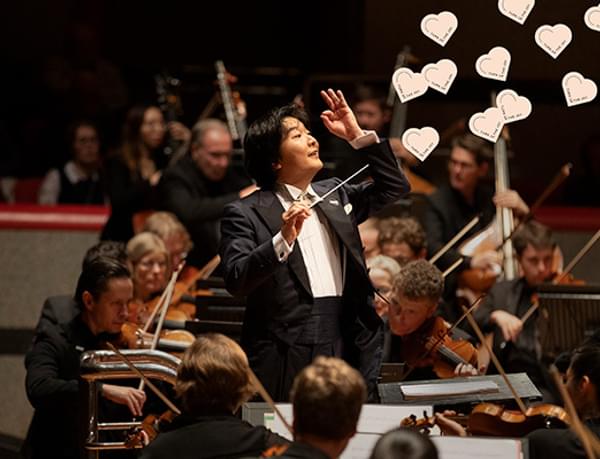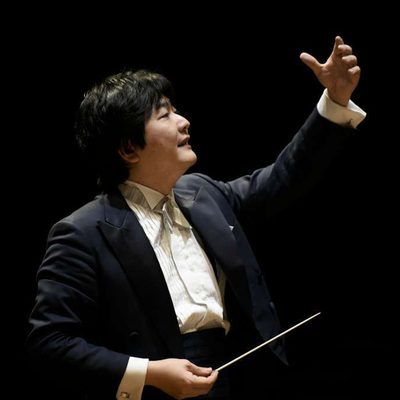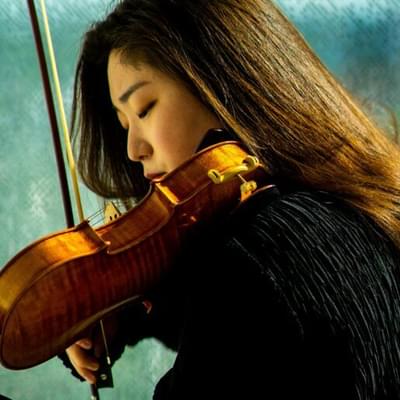Valentine's Day: Kazuki conducts Dvořák 9

Full programme
- Villa Lobos, Bachianas Brasileiras No.9 (10mins)
- Mendelssohn, Violin Concerto (26mins)
- Dvořák, Symphony No.9 (New World) (40mins)
Performers

Kazuki Yamada
Conductor
Suyoen Kim
Violin
Introduction
I am really looking forward to playing Mendelssohn’s Violin Concerto. It will be my first time visiting Birmingham and playing with the City of Birmingham Symphony Orchestra and I cannot wait to play alongside my good friend, Kazuki Yamada.
I know Kazuki from the Seiji Ozawa International Academy in Switzerland. Set up to workshop quartets, I was one of the first musicians to attend the Academy when it was founded in 2004 and now 20 years later, I am a teacher there. Kazuki joins us every year to work with the young musicians – it’s been a privilege to work with him and see his support for working with younger musicians. Growing as a musician alongside him has been very inspiring.
I am very familiar with Mendelssohn’s Violin Concerto. It is one of the first violin concertos I learnt growing up as a violinist and I have performed it many times in my professional career. However, I’ll be going into this performance with fresh eyes as it’s been a few years since I last performed it!
Everything in this concerto is so beautiful. Listen out for how the soloist and orchestra connect and communicate with each other – they dance around with each other throughout and it’s so fun to listen to.
The concerto offers a lot of opportunity for the soloist to feel and interpret the music in whatever way they wish (unlike some of the most well-known concertos by Beethoven or Mozart). Whether I choose to play it with a Baroque-style in mind or I want to explore some of the finer details throughout, it always feels very fresh and new to play.
Knowing Mendelssohn wrote the concerto with his concertmaster and good friend, Ferdinand David, makes it an even more beautiful piece to pay. As a concertmaster myself, I can appreciate this compositional relationship so much and wish it was more common for composers to work in this way now.
As for the other pieces in the concert, especially Dvořák's Symphony No.9 – what’s not to love?
I hope you enjoy this concerto as much as I enjoy playing it and I cannot wait to make my debut with the CBSO.
Suyoen Kim
Violin
Programme Notes
A rare chance to hear Brazilian composer Villa-Lobos’ brilliant take on Bach in one of his Bachianas Brasileiras. With one of the best opening tunes ever-written, Mendelssohn’s Violin Concerto is brilliantly played by Suyeon Kim. And speaking of great tunes - Kazuki Yamada leads the CBSO in Dvořák’s famous ‘New World’ Symphony, which is simply bursting with them.
Bachianas Brasileiras No.9
Heitor Villa-Lobos (1887-1959)
Brazilian composer Villa Lobos was a colourful character, full of stories about his life – some of them true – and with a fascinating catalogue of works. His early compositions displayed both traditional Brazilian and European Romantic influences, either separately or fused together in individual works. His tribute to JS Bach, Bachianas Brasileiras, is a perfect example of the latter: nine pieces, composed between 1930 and 1945, most of which combine a Brazilian form with a ‘Bachian’ form. The pieces are composed for a variety of different forces, from piano and orchestra (No.3) to flute and bassoon (No.6) to soprano and eight cellos (No.8). No.9, which uses only the Baroque forms of Prélude and Fugue, was scored for string orchestra, along with an alternative version for choir – both dating from 1945.
No.9 has a stately, almost reverential quality to it. The brief Prélude opens with a slow-moving, solemn melody over a ground bass note. The harmonies are luxurious, hinting at discords but only with the lightest touch. The opening of the Fugue is more Baroque in spirit, giving itself away as a twentieth century work through its occasional jazzy rhythms and the richness of its orchestration. The texture thickens towards the central part of the movement, with several melodies competing for attention, and becoming even more complex towards the end. Villa Lobos had conducted the Brazilian premiere of Bach’s Mass in B Minor in 1932, and for him Bach was not so much a composer as a manifestation of a fundamental, human spirit; ‘a universal folkloric source…emanating directly from the people.’ His Bachianas Brasileiras are a heartfelt expression of his belief that Bach’s music was ‘the most sacred gift to the world of art.’
Violin Concerto
Felix Mendelssohn (1809-1847)
The violinist Joseph Joachim declared in 1906 that of the four most famous German violin concertos (by Beethoven, Brahms, Bruch and Mendelssohn) the latter was the ‘dearest…the heart’s jewel.’ While the others may have been impressively ‘great’ and ‘serious,’ Joachim implies that Mendelssohn’s is the most delightful, though that does not mean that this beautifully-constructed work lacks in substance. It flows organically across three movement, and certainly belies the difficulty Mendelssohn had with its composition. He had conceived the idea of writing a concerto for his friend Ferdinand David as far back as 1838, burning as he was with a melody in E minor he could not get out of his head. But for various reasons – including ill health – the composition was held up, and it was not completed until 1844, premiering the following year.
While not sounding unconventional to contemporary ears, the Concerto broke new ground in several ways. To begin with, instead of an orchestral introduction the soloist is present right from the start, waiting only a bar and a half to begin. (This wonderfully memorable theme had been keeping Mendelssohn awake since the Concerto’s conception back in 1838 – ‘the opening gives me no peace’ he wrote to Ferdinand David.) The cadenza – normally a burst of virtuosity at the close of a movement – emerges from the orchestral texture about two-thirds of the way through. The orchestra, no mere backing group for the soloist, is far more participatory, with individual instruments taking on important solo roles. The bassoon, for example, links the first movement to the second with a lingering held note leading to a gentle theme. The rest of this glowing movement is sheer romance.
Between the end of the second movement and start of the third there is the briefest of breaths before the violin opens again with an initially unassuming melody. Fireworks start shortly after, however, with a joyously scurrying solo theme, breathlessly pursued by the orchestra up to the Concerto’s sparkling conclusion. At the Concerto’s first UK performance a gentleman in the front row reportedly beat time on the floor with his umbrella throughout the last movement; not recommended behaviour, but the infectious, rhythmic vitality of the finale makes it easy to understand why he did it.
Symphony No.9 (New World)
Antonín Dvořák (1841-1904)
Dvořák arrived in the USA – the ‘New World’ – in 1892, at the height of his fame. He had been invited by the wealthy Mrs Jeanette Thurber to take up the position of professor of composition at the National Conservatory of Music, based in New York. While reluctant to leave his beloved Bohemia, the temptation of the salary (some 25 times larger than the Prague Conservatory could offer) was too much to resist.
Having arrived, after sailing across the Atlantic in September 1892, Dvořák reported to friends:
The Americans expect great things of me. I am to show them the way into the Promised Land, the realm of a new, independent art, in short a national style of music! … I have plenty of encouragement to do so.
Cultivating a distinctly American style of composition had indeed been one of Mrs Thurber’s aims in inviting Dvořák to the States. Interested as he was in the folk music of his own country, Dvořák turned to the music of Black and indigenous Americans; some of this he will have found in published sources, but he also invited the Black singer Harry Burleigh – a student at the Conservatory – to sing traditional songs to him. The extent to which any of this made the resulting ‘New World’ Symphony ‘American’ has been hotly debated ever since. Leonard Bernstein, ever contrary, declared that the Symphony is strictly ‘Old World,’ ie a European Symphony sprinkled with a few traditional American touches. (He also makes the reasonable point that Dvořák was attempting to tap into a culture that was manifestly not his own, nor did it belong to other, largely white, American composers.)
Whatever its ‘American’ or other qualities, however, this Symphony has been rightly celebrated in the decades since its rapturously received premiere in 1893. Its principal problem these days is familiarity, which might cause listeners to miss the sheer drama of the work. From start to finish it embodies a constant push-pull between major and minor; between fire and light. The first movement alone is bursting with themes reflecting both moods: the opening melody, in a serious minor key, dominates the movement; the second, more folk-like, weaves in and out of the first, turning from minor to major; while a third, considerably more cheerful, is heralded by a solo flute. The dramatic opening theme ultimately ‘wins’ this movement, closing it with great ferocity.
The famous tune of the ‘Largo’ arrives after a stern brass chorale which frames the movement. The second theme is perhaps less well-known, but brilliantly off-sets the warmth of the first with its haunting and poignant quality. The Scherzo opens in a fierce mood, with a disconcerting off-kilter rhythm within its 3-in-a-bar time signature. Breezier major key themes intervene, engaged until the end of the movement in a tussle for dominance against the more turbulent style of the opening. A brief coda brings back themes from the first movement in a somewhat ghostly reprise.
The finale, similarly, hosts echoes of earlier movements as well as some new ones of its own; it is a gathering place, or a working-out of the dramas which have already taken place. The last minute is simply extraordinary: a blistering recurrence of the chorale which opened the second movement, then a hushed medley of themes from earlier, a dramatic build to a dissonant version of the movement’s main melody, an almost boogie-woogie-like stroll in the brass, followed by the final chords, gradually softening into silence.
© Lucy Walker